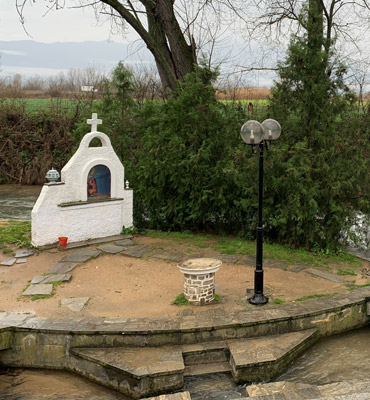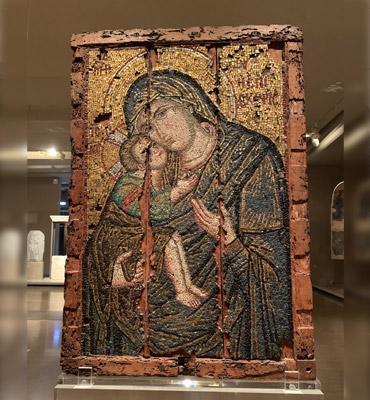Religious
PILGRIMAGES IN GREECE
Famous Churches and Monasteries in Greece:
1. Agios Ioannis Theologos (Saint John The Theologian), Patmos:
The Monastery of St. John the Theologian on Patmos, is possibly the most important monastery of the Aegean Sea. It was founded by the Blessed Christodoulos (1088) who was granted the island of Patmos exempt from taxation by an imperial chrysobull of Alexius I Comnenus and contains treasures of inestimable value.
2. Monastery of Hosios Loukas Steiriotis, Viotia: The monastery of Hosios Loukas is situated at a scenic site on the slopes of Mount Helicon. A fortress-like monastery, the most important monument of the mid-Byzantine period in Greece. Katholikon has an amazing frescoes and mosaics from the early 11th century, which have led it to be called a ‘small Agia Sophia’.
3. Daphni Monastery: The monastery lies to the west of Athens, almost half-way along the ancient Sacred Way to Eleusis. The first monastery was erected on the site in the 6th century A.D. and was enclosed by strong defensive walls, almost square in plan. Built on the site of an ancient temple of Apollo, it is one of the most important Byzantine monuments in the entire Mediterranean. It is on the Unesco list of World Heritage Sites.
4. New Monastery, Chios: One of the most important monasteries in Greece. 11th-century monastery on the island of Chios that has been recognized as a UNESCO World Heritage Site. The monastery is built by the Byzantine Eperor Constantine IX Monomachos in 1024. The monastery complex is about 17,000 m2 and consists of the katholikon, two smaller churches (dedicated to the Holy Cross and to St Panteleimon) the dining hall ("trapeza"), the monks' cells ("kelia"), the reception hall or "triklinon" and Underground Water cistern ("kinsterna").
5. Mystra: Mystras is situated on the slopes of Taygetos Mountain. The archaeological site stands above the modern village of Mystras and the city of Sparta. Including seven important churches in Mystra, all the katholika of monasteries: Pantanassa, still functioning as a monastery, Agios Dimitrios, Evangelistria, Perivleptou, Agia Sophia, Panagia Odigitria and Agii Theodori.
6. Panagia, Tinos: The faith of thousands in the miraculous powers of the icon of the Megalohari has turned this relatively recently built monastery (1880) into one of the major pilgrimage sites in Greece. Its festival day is August 15.
The shrine of the Holy Church of Panagia Evaggelistra of Tinos is the most important orthodox shrines of pilgrimage in Greece and one of the most famous throughout the world. The Church of Evaggelistra was built on the site where the Icon of the Annunciation of the Virgin Mary was miraculously discovered, after the Nun Pelagia had a vision. It is located on a prominent site in the Hora of Tinos. The Church is a three-aisled Basilica with a cupola over the Holy Altar.
7. Panagia Ekatontapiliani, Parikia, Paros: The Ekatontapiliani or Katapoliani is one of the most famous early-Christian monuments in Greece. The early Christian building complex Katapoliani consisting of a central large cruciform domed basilica dedicated to the Virgin Mary. The complex Katapoliani surrounded by small chapels and complex storey of cells and high enclosure whose construction phases dated to the 17th and 18th century.
8. Panagia Hozoviotissa, Amorgos: Built on a cliff-side overlooking the Aegean by Alexius I Comnenus, the monastery is the second oldest in Greece built in 1017 and renovated in 1088. It is literally hanging on the cliff side 300 m above the sea.
It houses the miraculous icon of the Virgin Mary, it is 40m metres high but only 5m deep.
9. Panagia Soumela: The original Soumela monastery located in Trabzon, Black sea cost of Turkey. It was an Orthodox symbol for 16 centuries. The icon of the Virgin Mary was transported to the new Panagia Soumela on the forested slopes of Mount Vermion.
10. Thessaloniki Churches: Thessaloniki is famous for its Byzantine churches. Important ones are Church of Acheiropoiitos, Church of Agios Dimitrios, Rotanda, Monastery of Latomou, Thessanoniki, Church of Agia Sophia, Panagia ton Chalkeon, Church of Agioi Apostoloi, Church of Saint Nicolaos Orfanou, Church of Agios Panteleimon.
11. Athens Churches: Athens has a number of important Byzantine and post-Byzantine churches: Palaia Mitropoli located near new Metropolitan, Kapnikarea on Ermou street, Aghios Nikolaos Ragkavas located on Plaka, Aghia Ekaterini on Plaka, Aghios Ioannis Theologos located on Plaka, Sotiras of Kotaki located on Plaka, Metochi Panagiou Tafou located on Anafiotika, Panagia Chrisokastriotissa located on Anafiotika, Sotira Lykodimus-Russian Church located on Filellinon Street, Aghioi Apostoloi of Solakis located on ancient Agora, Pantanassa located at Monastiraki Square, Aghios Dimitrios Loubardiaris located at Filopappos Hill, Aghioi Asomatoi located at Theseion, Aghios Ioannis stin Kolona located on Euripides Street, Aghioi Theodoroi located at Kafthmonos Square, Taksiarches church of Petrakis Monastery located on 14 Gennadiou Street, Aghioi Isidoroi located on Lycabetus Hill, Aghios Georgios located on Lycabetus Hill.
Mount Athos: An Orthodox spiritual centre since 1054, Mount Athos has enjoyed an autonomous statute since Byzantine times. The 'Holy Mountain', which is forbidden to women and children, is also a recognized artistic site. The layout of the monasteries (about 20 of which are presently inhabited by some 1,400 monks) had an influence as far afield as Russia, and its school of painting influenced the history of Orthodox art.
Meteora: In a region of almost inaccessible sandstone peaks, monks settled on these 'columns of the sky' from the 11th century onwards. Twenty-four of these monasteries were built, despite incredible difficulties, at the time of the great revival of the eremitic ideal in the 15th century. Their 16th-century frescoes mark a key stage in the development of post-Byzantine painting.
BIBLICAL REFERENCES FOR GREECE
Thessalonica - Acts 17: 1-9 is for the arrival of Paul and Silas in Thessalonica in AD 49. Thessaloniki is famous for its Byzantine churches, the church of the city’s patron saint Agios Dimitrios, Agia Sophia, Aheiropoiito and Panagia Halkeon, Agios Nikolaos Orfanos and Hosios David. A year later Paul wrote his first letter to the Thessalonians and shortly after his second letter. These letters shed light on some of the joys and sorrows of Pauls ministry.
Samothracia --Paul originally arrived here from Troas (Acts 16: 11), and arrived at the Island before proceeding the next day to the port city of Neapolis. It was the begining of his second missionary journey.
Philippi - This was the first city where Paul preached on his second journey (Acts 16: 11-40). It was a Roman colony founded by Augustus after the famous battle of Philippi. Lydia, the first convert to Christ, originally came from Thyatira (where, later, there was a church - see Revelation 2:18-20. Pauls and Silas imprisonment in Philippi are also referred to in 1 Thessalonians 2:2 and probably 2 Corinthians 11:25. Paul returned to Philippi (Acts 20:6) at the end of his journey before sailing to Troas (AD 51).
Berea --Acts 17:10-15 tells of Pauls visit to Berea and of the founding of a church. In Paul's day, Berea was a prosperous Roman city with a large Jewish community. The mosaics are located at the top of St. Paul's steps where it is believed that Paul addressed the crowds in 51AD.
Athens - Acts 16:34 tells of Pauls visit to Athens, his discussions with Athenian intellectuals and his preaching (AD 49). Athens has a number of important Byzantine and post-Byzantine churches: the Cathedral of Athens and next to it the beautiful Panagia Gorgoepikoos, Agios Nikolaos Ragkavas, Metamorfosi tou Sotiros in Plaka, Panagia Pantanassa in Monastiraki, Kapnikarea on Ermou street and Agii Asomati in Thisio.
Corinth - Acts 18:1-17 speaks of Pauls first visit (AD 50-51) to Corinth. He wrote 4 letters to the believers in Corinth. The first letter which is referenced in his second letter to the Corinthians (1 Corinthians 5:17) was lost. His second letter, that we call the (First Letter to the Corinthians) (AD 55) was written from Ephesus and sent by the hand of Timothy. Paul then revisited. One of the most important factors drawing Paul to Corinth was its strategic location on the narrow isthmus connecting central Greece to the southern land mass of the Peloponnese.
PLACE REFERENCE
Amphipolis Acts 17:1
Apollonia Acts 17:1
Athens Acts 17:15-16, 22; 18:1; 1 Thessalonians 3:1
Berea Acts 17:10, 13: 20:4
Cenchrea Acts 18:18, Romans 16:1
Coos (Kos) Acts 21:1
Corinth Acts 18:1; 19:1; 1 Corinthians 1:2; 2 Corinthians 1:1, 23; 2 Timothy 4:20
Cyprus Acts 4:38; 11:19,20; 13:4; 15:39; 21:3,16; 27:4
Neapolis (Kavala) Acts 16:11
Patmos Rev 1:9
Philippi Matthew 16:13; Mark 8:27; Acts 16:12, 22; 20:6; Philippians 1-4; 1 Thessalonians 2:2
Rhodes Act 21:1
Thessalonica Acts 17:1. 11. 13; 27:2; Philippians 4:16: 1 and 2 Thessalonians; 2 Timothy 4:10

